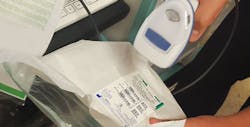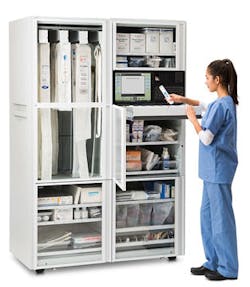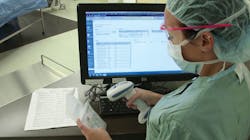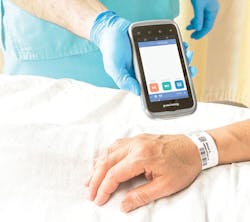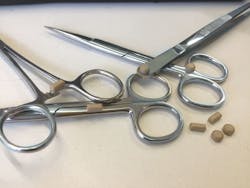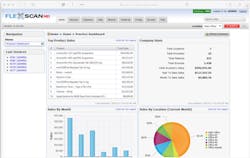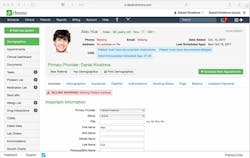As we move into the New Year, thanks to increasing reimbursement rates from private insurers, the future looks bright for for-profit hospitals, which are likely to see a 2.5 percent to 3 percent growth rate in 2018.1 But for not-for-profit and public healthcare facilities, the horizon looks a little dimmer as they continue to grapple with the same fiscal challenges as last year.2 Despite good inpatient volume, for these facilities, revenue growth is likely to plummet in the months ahead as spending continues to climb. This is according to a 2018 outlook report by Moody’s Investor Service which says low government reimbursement rates — which accounted for 61 percent of gross patient revenue in 2016 — clinical staff shortages, labor costs, bad debt, escalating insurance deductibles and co-pays, and increased spending on essential technology all play a role. However, it’s essential technology that could also play a role in leading healthcare providers closer to the light.
Big data is the big focus
Hospitals that provide quality care, greater efficiency and patient safety are likely to be using data analytics and other information gathering technologies to achieve their goals. Omnipresent connectivity — interoperability — is the target most facilities are aiming for. Compliance deadlines for GS1 standards are also approaching and while nearly all non-federal acute care hospitals have an electronic health record (EHR) system in place,3 not everyone see it as the seamless, communication dynamo it was meant to be — not without the right technology in place.
Capturing data at the point-of-care is one way that healthcare facilities are tying all of their once disparate data systems together in real-time — a practice that is likely to be as common as it is for clinicians to don personal protective equipment before starting a surgical procedure.
Franciscan Missionaries of Our Lady Health System (FMOLHS) is an admirable example of how perceptive planning and smart product selection can lead to success. The organization recognized a need to synthesize the varying content they generated and stored in multiple data systems. The goal, said William Mosser, Vice President, Materials Management, FMOLHS and LogisticsOne, was to connect the Supply Chain, Clinical and Financial departments so that they could immediately share and access each other’s information in a joint effort to improve care, eliminate waste, and cut unnecessary spending.
“We wanted to change the need for each system to utilize its own numbering and nomenclature methodologies, which force the providers to expend significant time trying to manually manipulate and maintain data that really isn’t ours,” explained Mosser. “We needed total system-to-system interoperability.”
Implementing a system that would allow clinicians to scan medical supplies at the point of use was part of the build. “Since we are very active in promoting and using GS1 Data Standards, we saw the opportunity to utilize manufacturers’ data, based on our contracts, to directly feed our Clinical Information System (EPIC) automatically,” explained Mosser. “The data required by EPIC (item number, description, UNSPSC Codes, HCPCS codes, dimensions, price and so one) are all known and driven by the manufacturer of the products we use. For us to take that data and translate it into other system-driven naming conventions simply makes no sense. The GS1 data standards that the manufacturers feed into the required data pools meet all of our expectations. The challenge was to find someone who would be willing to work with us to connect the dots … and make this all interoperable.”
FMOLHS was satisfied with the various supply chain management technologies they were already using from GHX so they decided to enlist another application from the vendor to help make their vision a reality. “They are a trusted partner and one who already had the wherewithal to understand the need and help drive the change,” Mosser said. They adopted GHX’s ClinicalConnexion solution and point-of-care barcode scanning which increased OR efficiency significantly since clinicians no longer had to manually key in surgical supplies to patient EHRs. Charge capture also increased dramatically from 40 percent to 95 percent, along with other benefits that prompted the organization to implement EPIC and ClinicalConnexion across FMOLHS’s entire healthcare system.
“Our clinical teams simply capture what is used via EPIC tools and bar coding and the ClinicalConnexion feeds the required data to allow us a clearer picture of cost per episode of care, including highlighting financial variation in similar procedures and care plans,” said Mosser. “We have immediate access to information that was previously maintained in different systems, with different keys that required manual intervention to align the data points. Plus we don’t need to maintain our item master with staff manually updating elements that are all owned and maintained by the manufacturers.
“In the end, the investment is minimal compared to the benefit of seeing first hand, what devices and supplies are used by physician for each episode of care,” he continued. “The level of data we have available for identifying costs and revenue improvement opportunities are fantastic. And providing this level of data to our physicians and clinical leaders allows us to have more evidence-driven decisions to achieve best practice clinical outcomes.”
“The introduction of the Universal Device Identifier (UDI) initiative created broader mandates surrounding the tracking and tracing, and chain of custody, of these critical products. With the current Class 2 and Class 3 UDI requirements in place, it is federally required that patient identification is tied to the use of these products,” added Robert Sobie, Senior Worldwide Director & Business Leader at BD.”With a POU tracking system in place inside the procedural/OR rooms it’s easier for the circulating nurse to document patient specific usage of these items while allowing interoperability between systems to reduce clinical documentation time and increasing accuracy. This can also be accomplished with systems outside of the procedural/OR rooms but would require the circulating nurse to leave the room during the case potentially increasing the possibility of nosocomial and surgical site infection rates with repeated exits and reentry.
“A correctly deployed tracking system allows inventory tracking and data confirmation in real time eliminating the need to wait until the conclusion of the procedure to do this,” continued Sobie. “Postponing this documentation until the end of the procedure can increase the turnover time thereby decreasing efficiency and causing costly delays. Lastly, the digital integration reduces the time spent with inventory reconciliation, order entry, order tracking, audit and recall management, all things that ultimately increase labor costs and the risk of a stock-out event.”
Sobie discussed the success that the multi-site Memorial Hermann Healthcare System has after implementing the BD Pyxis system in an effort to eliminate the time-consuming task of manually loading and locating products, improve accuracy of inventory information, address duplicate data entry and other issues. “With concerns over increasing labor and supply costs, regulatory compliance and patient and caregiver satisfaction, the Supply Chain team at Memorial Hermann worked in conjunction with their OR clinical counterparts to implement the connected, end-to-end supply solution from BD Pyxis,” Sobie said. “By deploying this advanced tracking system Memorial Hermann has also successfully implemented the GS1 standards and have been tracking Universal Device Identification (UDI) information for over five years.”
Also, recall management labor decreased 95 percent and staff now spends less than one hour a day managing implantables, physician-specific and trunk stock inventory. “By working together with BD Pyxis we’ve created a truly end-to-end patient care focus from the point-of-order through the point-of-use by the entire Hermann team” said Chris Toomes, Regional Director of Operations, Memorial Hermann Healthcare System. “We now digitally track the use of medical devices from the time the order is placed until they time they are used on a specific patient. We integrate the data usage and product disposition information into other systems and processes to increase accuracy and create new efficiencies. By using medical device consumption data to drive clinical and supply chain decisions, Memorial Hermann has been able to substantially reduce costs, the number of suppliers used and our business operations.”
Perfecting physician preference cards
As the cost of labor and medical products increases, facilities must find proven ways to bolster productivity and savings in all departments, including the central sterile/sterile processing department where outdated physician preference cards are filled, causing a lot of wasted time and money.
“The key to doing this effectively is streamlining process and the supplies and equipment used during a procedure; if hospitals are not documenting that information, they may be picking and sterilizing extra items that are rarely used,” said Suzanne Alexander-Vaughn, Senior Product Manager, Omnicell. “This causes unnecessary activity in purchasing, central sterile supply, case pick operations, operating room setup, and room turnover times. Reducing these inefficiencies also allows the organization to refocus clinical staff time to patient care instead of administrative tasks.”
She recalled how one large healthcare system consisting of several hospitals had adopted Omnicell’s inventory management solution to tackle its widespread, unnecessary waste and inaccurate utilization data. The health system’s large anchor hospital kicked off the launch but only after spending considerable time making changes to all of the cards — a task they soon realized they should have skipped. “They invested a large chunk of time reviewing and cleaning up preference cards so their data would be as clean as possible at go live, though these preferences were based on what they thought they used instead of actual tracked data,” said Alexander-Vaughn. “One of the smaller hospitals in the same system elected to go live once all their items were in the system and scanned everything. They understood that the preference card data they had on record was not maintained and wanted to have a fresh start on tracking their inventory utilization. By scanning all the items at the time of the procedure, at the beginning of the install, they were able to start fresh and understand what was really used in a procedure. Over time they were able to pull fewer supplies and free up valuable space in their OR core because some items were being picked on a regular bases but not utilized. They now had the data to understand and support these decisions, as well as reduce case pick time.”
Anders Larsson, Vice President, Healthcare Marketing, TECSYS, shares a similar view: “When you have a pulse on inventory status and movements, and are able to link consumption to procedures for case costing analytics, you are well-equipped to address fluctuations, shortages or oversupply proactively,” Larsson emphasized. “A key problem we see in the OR is trying to get case cart contents to match the needs of the OR team for a procedure. Add to that, unnecessary items are compromised during the return process. By tracking what is picked, consumed and returned, real-time tracking translates into opportunities for frequent preference card optimization so that case cart content is better reflective of what is truly needed, and those supply-related disruptions are eliminated.
“Together with visibility on consigned inventory and accurate preference cards, these systems facilitate demand planning and forecasting based on the OR schedule,” Larsson continued. “This means potential problems can be identified so preventive actions can be taken. Further, tracking UDIs at inventory locations from the point of receiving prevents waste due to expiration and makes for easy recall management. With a tight integration, a single scan of the product barcode will create both a requisition and a record in the EMR so less time is spent in front of the computer during procedures and accurate input is secured. A recent OR transformation that embedded these operating principles showed significant value and is projected to generate $11 million to $13 million over four years while breaking down operating silos by improving collaboration across all stakeholders.”
Promoting patient safety
Point-of-care item capture in the OR also supports patient safety initiatives, suggested Alexander-Vaughn. “We all know of stories where some item other than an implant could have caused harm to a patient or something was learned about the patient after surgery that could cause harm to other patients,” Alexander-Vaughn said. “Having records of what was used is essential to reducing both existing and future harm associated with surgery.”
Genesis, an international provider of traceability solutions, offers an automated tracking platform that has been implemented in numerous facilities, including the British Salisbury NHS Foundation Trust. Genesis Automation CEO Guillermo Ramas says Genesis Automation was adopted there to support the country’s Scan4Safety initiative, a pioneering program led by the UK Department of Health that aims to improve patient safety, increase clinical productivity and drive operational efficiency.
“Salisbury NHS Foundation Trust faced the problem of managing product recalls quickly and efficiently to safeguard patients from avoidable harm,” said Ramas. “Although the Trust had product recall processes in place, these were manual and extremely time-consuming. There was no process or single system in place for identifying or capturing implants used with a patient in a consistent or repeatable way across the Trust. While hard to quantify the exact amount of time spent on a product recall, anecdotal feedback suggested product recalls could take ‘many hours’ of trawling through patient records and often involved highly skilled and senior members of clinical staff.
“Salisbury implemented the right system, and as a result, all implants are tracked to patient and easily reported on, if needed, due to recall,” Ramas continued. “Clinical staff time was freed up from supply management; at Salisbury, before implementing, 30 percent of staff in their ortho operating rooms dedicated more than one hour a shift on stock-related duties. Salisbury ended up redirecting thousands of hours of clinical staff from supply-related activities to patient care.”
When asked what healthcare facilities should be most mindful of when researching OR tracking systems, Ramas stated: “The ideal system needs to properly track supplies from the time they are received in the hospital (wherever in the hospital that may be), until they are used on a patient, and needs to provide the resulting information everywhere the organization needs it: the EHR for case documentation, CMO office and surgeons for analytics and peer benchmarking, Finance for analytics, supply chain for inventory management and procurement transactions, and even reaching the supplier for proper coordination.”
For those still on fence about adopting one, Ramas offers some good reasons to make the investment: “Not having the right system will mean these organizations are operating without clear visibility into all aspects of their activity, and more importantly, with the inability to fully guarantee patient safety when executing on recalls or managing supply expiry. Many organizations still rely on manual input processes, that introduce errors due to typos and lack of compliance.”
“The main benefit of tracking instruments and surgical supplies is to effectively tackle human errors. Be it missing or failed instruments, ultimately RSI, the root causes are the same and directly impact patient safety,” said Michel Gillmann, Marketing Director, Xerafy. “A performing surgical instrument tracking (SIT) allows for a fully automated tracking throughout the OR and reprocessing. It gives visibility to all stakeholders and ensures automatic data capture at each control point, with minimum impact on your staff. In the absence of such a system, you will find that your patients are at risk, not to mention your processes, reputation and revenues.
“Rigshospitalet in Copenhagen, Denmark, is a pretty large facility and they came up with some compelling numbers,” continued Gillmann. “Out of the 75,000 surgeries they perform per year, they estimated they could save a total of 31,000 hours in the OR, based on automated and error-free surgical counts. Add in the costs of lost instruments and other waste, and you quickly reach a few millions in potential savings for an average hospital. On the revenue side, you are looking at minimizing the impact of missing instruments on your OR schedule and faster turnover time for your surgical suites. Rigshospitalet put the number at up to 10,000 additional surgeries a year.
Ramping up reimbursement
Cory Turner, CMRP, Supply Chain Strategy Director, Healthcare, Infor, says relying on manual input also has the potential to increase missed item captures and data errors, which can lead to costly billing mistakes and smaller reimbursements.
“Lost charges for billable supplies translate directly into lost revenue opportunities,” said Turner. “Supply expenses can account for 20 percent to 50 percent of your total operating budget, so capturing billable supply charges is crucial to covering your costs. The lost productivity of staff engaged in a manual version of charge processing also presents an opportunity for improvement.”
He says Infor’s point of use application can reduce lost charges, manage high-value inventory in clinical areas and drive profitability with each episode of care, connect quickly and securely with existing clinical applications, eliminate the need for expensive cabinet based systems, increase staff efficiencies and replenish stock more accurately.
Make the investment and upgrade
Gillman says too many hospitals are still using first generation tracking systems that can’t deliver what the newer versions can.
“[The older systems] basically track trays and rely on manual scanning, for instance barcodes,” he said. “Their return on experience is usually of a ‘black hole’ in the OR, where manual scanning goes in the way of compliance. On the reprocessing side, they struggle with the longevity of barcode tags and other first generation marking methods, which from experience is far shorter than the lifecycle of instruments and other devices. Hospitals looking to upgrade their tracking system focus on full automation and the ability to ‘force’ data capture, while upgrading the technology to support item-level tracking, in line with the FDA’s UDI regulation.
“Hospitals starting from scratch on the other hand are keen on moving directly onto the next generation of tracking systems, like Xerafy’s,” Gillman continued. “Their concern is usually to be able to track as many instruments and devices as possible, and thus to unlock their tracking system’s full potential. Xerafy’s technology allows for close to 99 percent of instruments, devices and hospital assets to be tracked, using autoclavable tags.”
Using an iPad and iPhone, the drchrono EHR integrated FlexScanMD inventory management system also enables clinicians to order medication and supplies at the point of care in real-time while simultaneously sending usage data to inventory and patient records. FlexScanMD and drchrono partnered up to launch the solution in mid-December.
“This integration with FlexScanMD helps the medical personnel to easily order and dispense necessary medical supplies as needed without having to use a bulky computer system or having to leave the OR room,” said Daniel Kivatinos, Co-Founder and COO, drchrono. “They can simply order and have someone bring the ordered items straight to the OR in real time and automatically update patient records.”
“It is common for hospitals to manually track their supplies and medications in an Excel spreadsheet or, worse yet, in a paper log,” added Aaron Gerber, Director of Business Development, FlexScanMD. “This is done due to a lack of communication between a hospital’s inventory management software, EHR and practice management system. Entering duplicate data in multiple systems creates errors and wastes time. FlexScanMD’s integration with drchrono solves this problem.”
“FlexScanMD fully integrates with most available health-grade-rated barcode scanners specifically designed for use in OR settings. Moreover, medical staff in the OR frequently need to track the lot numbers of products received into inventory and later dispensed to patients. It is impossible to do this by scanning the manufacturer UPC symbol on the product because it simply identifies the brand and is not unique,” continued Gerber. “FlexScanMD facilitates this by allowing surgical staff to print their own barcodes from the system to uniquely identify each product by lot number. This permits them to a track the exact location of every product brought into inventory, whether it has been used in surgery, received by a patient, or is currently sitting on a shelf in inventory.”
The product also tracks manufacturer expiration dates and alerts users to “break-open” expiration dates as soon as they arrive, and it streamlines the preference card and billing processes. “Prior to the operation, staff in the OR run reports to gather a surgeon’s preferred equipment and scan each item to verify its use during surgery,” said Gerber. “After the procedure, the scanned items are automatically attached to a patient bill and transferred to the drchrono practice management system for insurance billing.”
For tips on savvy tracking system selection, visit www.hpnonline.com/be-choosy-choosing-new-technology/.
References:
About the Author

Valerie J. Dimond
Managing Editor
Valerie J. Dimond was previously Managing Editor of Healthcare Purchasing News.
